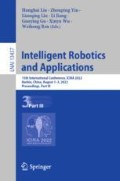Abstract
Force information is an indispensable and essential factor in vascular interventional surgery, which significantly affects the accuracy and safety of the procedure. This paper designs a new force sensing module for the vascular interventional robot, which measures the propulsion resistance and twisting torque during catheter and guidewire actuation. The FEA simulation is used to analyze the stress of the elastic body, and to establish the appropriate structure statically. The voltage signal is amplified, filtered and then transmitted wirelessly via Bluetooth. Finally, the force sensing module is subjected to a static calibration experiment, and the acquired signal is filtered using the Kalman filter algorithm. The experimental results have shown that the force sensing module exhibits good linearity and accuracy.
Access this chapter
Tax calculation will be finalised at checkout
Purchases are for personal use only
References
Khera, A.V., Kathiresan, S.: Genetics of coronary artery disease: discovery, biology and clinical translation. Nat. Rev. Genet. 18(6), 331–344 (2017)
Hu, S., et al.: Summary of the 2018 report on cardiovascular diseases in China. Chin. Circ. J. 34(3), 12 (2019)
Alatoom, A., Farhat, J., Dhou, S.: Review of image-guided percutaneous coronary interventions. In: 2019 Advances in Science and Engineering Technology International Conferences (2019)
Kanagaratnam, P., Koa-Wing, M., Wallace, D.T., Goldenberg, A.S., Peters, N.S., Wyn Davies, D.: Experience of robotic catheter ablation in humans using a novel remotely steerable catheter sheath. J. Intervent. Card. Electrophysiol. 21(1), 19–26 (2008). https://doi.org/10.1007/s10840-007-9184-z
Swaminathan, R.V., Rao, S.V.: Robotic-assisted transradial diagnostic coronary angiography. Cathet. Cardiovas. Interv. 92(1), 54–57 (2018)
Khan, E.M., et al.: First experience with a novel robotic remote catheter system: Amigo™ mapping trial. J. Interv. Card. Electrophysiol. 37(2), 121–129 (2013). https://doi.org/10.1007/s10840-013-9791-9
Payne, C.J., Rafii-Tari, H., Yang, G.Z.: A force feedback system for endovascular catheterisation. In: IEEE/RSJ International Conference on Intelligent Robots & Systems. IEEE (2012)
Guo, S., et al.: Study on real-time force feedback for a master–slave interventional surgical robotic system. Biomed. Microdev. 20(2) (2018). Article number: 37. https://doi.org/10.1007/s10544-018-0278-4
Guo, J., et al.: A vascular interventional surgical robotic system based on force-visual feedback. IEEE Sens. J. 19(23), 11081–11089 (2019)
Noh, Y., et al.: Image-based optical miniaturized three-axis force sensor for cardiac catheterization. IEEE Sens. J. 16(22), 7924–7932 (2016)
Acknowledgment
This work was greatly supported by the National Natural Science Foundation of China (Grant No. 61973210) and the Medical-engineering Cross Projects of SJTU (Grant Nos. YG2019ZDA17, ZH2018QNB23).
Author information
Authors and Affiliations
Corresponding author
Editor information
Editors and Affiliations
Rights and permissions
Copyright information
© 2022 The Author(s), under exclusive license to Springer Nature Switzerland AG
About this paper
Cite this paper
Fu, Z., Yao, J., Fu, Z., Sui, C., Fei, J. (2022). Design of Wireless Force Sensing Module of Vascular Interventional Robot. In: Liu, H., et al. Intelligent Robotics and Applications. ICIRA 2022. Lecture Notes in Computer Science(), vol 13457. Springer, Cham. https://doi.org/10.1007/978-3-031-13835-5_32
Download citation
DOI: https://doi.org/10.1007/978-3-031-13835-5_32
Published:
Publisher Name: Springer, Cham
Print ISBN: 978-3-031-13834-8
Online ISBN: 978-3-031-13835-5
eBook Packages: Computer ScienceComputer Science (R0)

